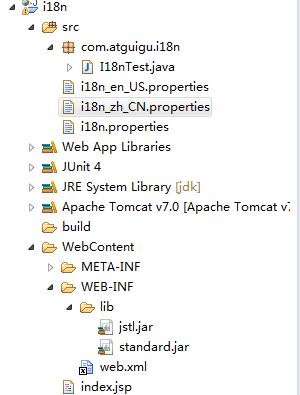1. 什么是国际化和本地化:
I. 本地化:一个软件在某个国家或地区使用时,采用该国家或地区的语言,数字,货币,日期等习惯。
II. 国际化:软件开发时,让它能支持多个国家和地区的本地化应用。使得应用软件能够适应多个地区的语言和文化风俗习惯
III. 本地敏感数据: 随用户区域信息而变化的数据称为本地信息敏感数据。例如数字,货币, 日期,时间等数据
2. 相关的 API:
I. DateFormat 和 SimpleDateFormat √.
II. NumberFormat
III. MessageFormat
IV. ResourceBundle
V. Locale
3. 关于国际化资源文件:
I. properties 文件格式
II. 必须提供 基名.properties 文件和 基名_语言代码_国家代码.properties 文件
III. 相同的 基名 的资源文件必须有相同的 key.
IV. 可能需要使用 native2ascii 工具把非 asc 码转为 asc 码.
4. WEB 的国际化
I. 可以使用 request.getLocale() 获取 Locale 对象
II. 可以使用 JSTL 的 fmt 标签完成的国际化. 后面使用框架提供的标签完成.
III. 实现 "中文" "英文" 的切换:
> 提供两个超简洁. 携带不同的变量值
> 根据变量值确定对应的 Locale 对象
> 把 Locale 对象放入到 session 中
> 绑定 Locale 对应的资源文件.
IV. 其他 fmt 标签可以参考 standard-examples.war 中的例子.
5.代码区


package com.atguigu.i18n;
import java.text.DateFormat;
import java.text.MessageFormat;
import java.text.NumberFormat;
import java.text.ParseException;
import java.text.SimpleDateFormat;
import java.util.Date;
import java.util.Locale;
import java.util.ResourceBundle;
import org.junit.Test;
public class I18nTest {
/*
@Test
public void testMessageFormat2(){
String str = "Date: {0}, Salary: {1}";
Locale locale = Locale.CHINA;
Date date = new Date();
double sal = 12345.12;
StringBuffer result = new StringBuffer();
FieldPosition fieldPosition = new FieldPosition(0);
MessageFormat messageFormat = new MessageFormat(str, locale);
messageFormat.format(date, result, fieldPosition);
System.out.println(result);
}
*/
/**
* ResourceBundle: 资源包类.
*
* 1. 在类路径下需要有对应的资源文件: baseName.properties. 其中 baseName 是基名.
* 2. 可以使用 基名_语言代码_国家代码.properties 来添加不同国家或地区的资源文件. i18n_zh_CN.properties
* 3. 要求所有基名相同的资源文件的 key 必须完全一致.
* 4. 可以使用 native2ascii 命令来得到 汉字 对一个的 asc 码. Eclipse 内置了工具
* 5. 可以调用 ResourceBundle 的 getBundle(基名, Locale 实例) 获取获取 ResourceBundle 对象
* 6. 可以调用 ResourceBundle 的 getString(key) 来获取资源文件的 value 字符串的值.
* 7. 结合 DateFormat, NumberFormat, MessageFormat 即可实现国际化.
*
*/
@Test
public void testResourceBundle(){
Locale locale = Locale.CHINA;
ResourceBundle resourceBundle = ResourceBundle.getBundle("i18n", locale);
//日期 工资
System.out.println(resourceBundle.getString("date"));
System.out.println(resourceBundle.getString("salary"));
String dateLabel = resourceBundle.getString("date");
String salLabel = resourceBundle.getString("salary");
String str = "{0}:{1}, {2}:{3}";
Date date = new Date();
double sal = 12345.12;
DateFormat dateFormat = DateFormat.getDateInstance(DateFormat.MEDIUM, locale);
String dateStr = dateFormat.format(date);
NumberFormat numberFormat = NumberFormat.getCurrencyInstance(locale);
String salStr = numberFormat.format(sal);
String result = MessageFormat.format(str, dateLabel, dateStr, salLabel, salStr);
//日期:2018-1-18, 工资:¥12,345.12
System.out.println(result);
}
/**
* MessageFormat: 可以格式化模式字符串
* 模式字符串: 带占位符的字符串: "Date: {0}, Salary: {1}"
* 可以通过 format 方法会模式字符串进行格式化
*/
@Test
public void testMessageFormat(){
String str = "Date: {0}, Salary: {1}";
Locale locale = Locale.CHINA;
Date date = new Date();
double sal = 12345.12;
DateFormat dateFormat = DateFormat.getDateInstance(DateFormat.MEDIUM, locale);
String dateStr = dateFormat.format(date);
NumberFormat numberFormat = NumberFormat.getCurrencyInstance(locale);
String salStr = numberFormat.format(sal);
String result = MessageFormat.format(str, dateStr, salStr);
//Date: 2018-1-18, Salary: ¥12,345.12 定义信息格式
System.out.println(result);
}
/**
* NumberFormat: 格式化数字到数字字符串, 或货币字符串的工具类
* 1. 通过工厂方法获取 NumberFormat 对象
* NumberFormat.getNumberInstance(locale); //仅格式化为数字的字符串
* NumberFormat.getCurrencyInstance(locale); //格式为货币的字符串
*
* 2. 通过 format 方法来进行格式化
* 3. 通过 parse 方法把一个字符串解析为一个 Number 类型.
*/
@Test
public void testNumberFormat() throws ParseException{
double d = 123456789.123d;
Locale locale = Locale.FRANCE;
NumberFormat numberFormat = NumberFormat.getNumberInstance(locale);
String str = numberFormat.format(d);
//123 456 789,123
System.out.println(str);
NumberFormat numberFormat2 = NumberFormat.getCurrencyInstance(locale);
str = numberFormat2.format(d);
//123 456 789,12 €
System.out.println(str);
str = "123 456 789,123";
d = (Double) numberFormat.parse(str);
//1.23456789123E8
System.out.println(d);
str = "123 456 789,12 €";
d = (Double) numberFormat2.parse(str);
//1.2345678912E8
System.out.println(d);
}
@Test
public void testDateFormat2() throws ParseException{
String str = "1990-12-12 12:12:12";
DateFormat dateFormat = new SimpleDateFormat("yyyy-MM-dd hh:mm:ss");
//Wed Dec 12 00:12:12 CST 1990
Date date = dateFormat.parse(str);
System.out.println(date);
}
/**
* DateFormat: 格式化日期的工具类.
* DateFormate 本身是一个抽象类.
*
* 1. 若只希望通过 DateFormat 把一个 Date 对象转为一个字符串, 则可以通过 DateFormat 的工厂方法来获取 DateFormat 对象
* 2. 可以获取只格式化 Date 的 DateFormat 对象: getDateInstance(int style, Locale aLocale)
* 3. 可以获取只格式化 Time 的 DateFormat 对象: getTimeInstance(int style, Locale aLocale)
* 4. 可以获取既格式化 Date, 也格式化 Time 的 DateFormat 对象:
* getDateTimeInstance(int dateStyle, int timeStyle, Locale aLocale)
* 5. 其中 style 可以取值为: DateFormat 的常量: SHORT, MEDIUM, LONG, FULL. Locale 则为代表国家地区的 Locale 对象
* 6. 通过 DateFormat 的 format 方法来格式化个 Date 对象到字符串.
*
* 7. 若有一个字符串, 如何解析为一个 Date 对象呢 ?
* I. 先创建 DateFormat 对象: 创建 DateFormat 的子类 SimpleDateFormat 对象
* SimpleDateFormat(String pattern).
* 其中 pattern 为日期, 时间的格式, 例如: yyyy-MM-dd hh:mm:ss
* II. 调用 DateFormat 的 parse 方法来解析字符串到 Date 对象.
*
*/
@Test
public void testDateFormat(){
Locale locale = Locale.CHINA;
Date date = new Date();
//Thu Jan 18 14:29:48 CST 2018
System.out.println(date);
//获取 DateFormat 对象 2018年1月18日 14:30:29
DateFormat dateFormat =
DateFormat.getDateTimeInstance(DateFormat.LONG, DateFormat.MEDIUM, locale);
String str = dateFormat.format(date);
System.out.println(str);
}
/**
* Locale: Java 中表示国家或地区的类. JDK 中提供了很多常量.
* 也可以通过 Locale(languageCode, countryCode) 的方式来创建
* 在 WEB 应用中可以通过 request.getLocale() 方法来获取.
*/
@Test
public void testLocale(){
Locale locale = Locale.CHINA;
// 中国 zh
System.out.println(locale.getDisplayCountry());
System.out.println(locale.getLanguage());
// 美国 en
locale = new Locale("en", "US");
System.out.println(locale.getDisplayCountry());
System.out.println(locale.getLanguage());
}
}

date=Date salary=Salary

date=\u65E5\u671F salary=\u5DE5\u8D44

date=Date salary=Salary

<?xml version="1.0" encoding="UTF-8"?>
<web-app xmlns:xsi="http://www.w3.org/2001/XMLSchema-instance" xmlns="http://java.sun.com/xml/ns/javaee" xmlns:web="http://java.sun.com/xml/ns/javaee/web-app_2_5.xsd" xsi:schemaLocation="http://java.sun.com/xml/ns/javaee http://java.sun.com/xml/ns/javaee/web-app_2_5.xsd" id="WebApp_ID" version="2.5">
<display-name>i18n</display-name>
<welcome-file-list>
<welcome-file>index.html</welcome-file>
<welcome-file>index.htm</welcome-file>
<welcome-file>index.jsp</welcome-file>
<welcome-file>default.html</welcome-file>
<welcome-file>default.htm</welcome-file>
<welcome-file>default.jsp</welcome-file>
</welcome-file-list>
</web-app>

<%@page import="java.util.Locale"%>
<%@page import="java.util.Date"%>
<%@ page language="java" contentType="text/html; charset=UTF-8"
pageEncoding="UTF-8"%>
<%@ taglib prefix="fmt" uri="http://java.sun.com/jsp/jstl/fmt" %>
<%@ taglib prefix="c" uri="http://java.sun.com/jsp/jstl/core" %>
<!DOCTYPE html PUBLIC "-//W3C//DTD HTML 4.01 Transitional//EN" "http://www.w3.org/TR/html4/loose.dtd">
<html>
<head>
<meta http-equiv="Content-Type" content="text/html; charset=UTF-8">
<title>Insert title here</title>
</head>
<body>
<%
Date date = new Date();
request.setAttribute("date", date);
request.setAttribute("salary", 12345.67);
%>
<%--
<fmt:bundle basename="i18n">
<fmt:message key="date"></fmt:message>:
<fmt:formatDate value="${date }"/>,
<fmt:message key="salary"></fmt:message>:
<fmt:formatNumber value="${salary }"></fmt:formatNumber>
</fmt:bundle>
<br><br>
--%>
<%
String code = request.getParameter("code");
if(code != null){
if("en".equals(code)){
session.setAttribute("locale", Locale.US);
}else if("zh".equals(code)){
session.setAttribute("locale", Locale.CHINA);
}
}
%>
<c:if test="${sessionScope.locale != null }">
<fmt:setLocale value="${sessionScope.locale }"/>
</c:if>
<fmt:setBundle basename="i18n"/>
<fmt:message key="date"></fmt:message>:
<fmt:formatDate value="${date }" dateStyle="FULL"/>,
<fmt:message key="salary"></fmt:message>:
<fmt:formatNumber value="${salary }" type="currency"></fmt:formatNumber>
<br><br>
<a href="index.jsp?code=en">English</a>
<a href="index.jsp?code=zh">中文</a>
</body>
</html>


来源:https://www.cnblogs.com/ou-pc/p/8310261.html
